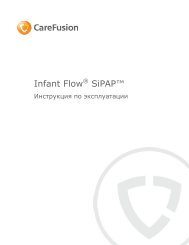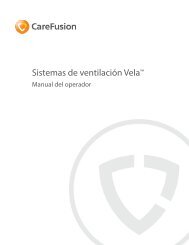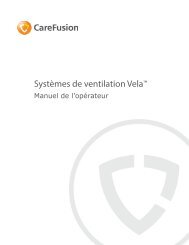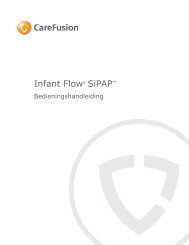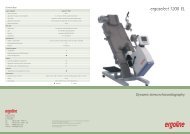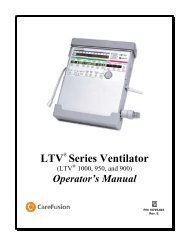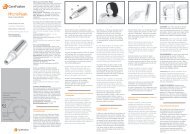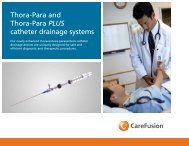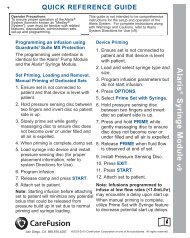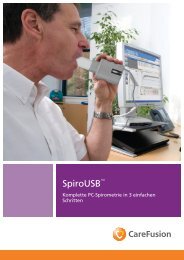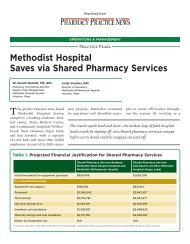LTV 1100 Operator Manual - CareFusion
LTV 1100 Operator Manual - CareFusion
LTV 1100 Operator Manual - CareFusion
You also want an ePaper? Increase the reach of your titles
YUMPU automatically turns print PDFs into web optimized ePapers that Google loves.
HIGH PRES<br />
When the pressure in the patient circuit is greater than the High Pressure Limit setting, the HIGH<br />
PRES alarm is generated. When this alarm occurs, any inspiration in progress is terminated and the<br />
exhalation valve is opened. The turbine is stopped to allow the circuit pressure to evacuate when the<br />
high pressure condition persists for more than four times the set inspiratory time or more than 3.0<br />
seconds, whichever is less.<br />
WARNING<br />
Sustained HIGH PRES Alarm - During a sustained High Pressure alarm condition (HIGH PRES), the<br />
ventilator’s turbine is stopped and gas is not delivered to the patient. Disconnect the patient from the<br />
ventilator and ventilate the patient using an alternative method. See Chapter 15 - Troubleshooting,<br />
Alarms for additional information concerning the HIGH PRES alarm.<br />
AVERTISSEMENT<br />
Alarme ALARME PMAX continue — Dans des conditions d’alarme de haute pression prolongées<br />
(ALARME PMAX), la turbine du ventilateur s'arrête et le gaz n’est plus transmis au patient.<br />
Débranchez le patient du ventilateur et utilisez une autre méthode de ventilation. Pour plus de détails<br />
sur l’état ALARME PMAX, reportez-vous au chapitre 15, Troubleshooting, Alarms.<br />
Immediate or delayed audible alarms for high pressure conditions can be selected using the<br />
Extended Features 32 . If immediate notification is selected, the audible alarm will sound on every high<br />
pressure occurrence. If Delayed notification is selected, the audible alarm will sound on the second or<br />
third consecutive breath terminated by the HIGH PRES alarm. The audible alarm will sound anytime<br />
a high pressure condition persists which stops the turbine.<br />
NOTE<br />
The High Pressure alarm output signal is generated by the ventilator’s Patient Assist Port for use with<br />
Remote Alarm systems. This signal is dependent on the selected setting (NORMAL or PULSE) in the<br />
Extended Features, PNT ASSIST menu. See Chapter 10 - Extended Features, Alarm Operations, for<br />
instructions on setting the Patient Assist Port output signal for use with single or dual tone Remote<br />
Alarm systems.<br />
REMARQUE<br />
Le signal de sortie correspondant à l’alarme de pression élevée est généré sur le port d’assistance au<br />
patient pour une utilisation avec des systèmes d’alarme à distance. Ce signal dépend du réglage<br />
choisi (NORMAL ou IMPULSION) dans le menu Fonctions avancées, PNT ASSIST. Reportez-vous<br />
au chapitre 10, Extended Features, Alarm Operations pour plus de détails sur le réglage du signal de<br />
sortie sur le port d’assistance au patient et sur son utilisation avec des systèmes d’alarme à distance<br />
à fréquence simple ou double.<br />
32 For more information on selecting the High Pressure Alarm Delay, see Chapter 10 - Extended Features.<br />
21106-001 Rev. E <strong>Operator</strong>’s <strong>Manual</strong> - <strong>LTV</strong> ® <strong>1100</strong> Ventilator 9-13



